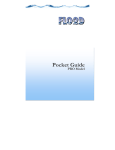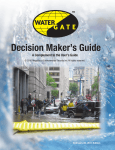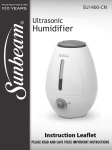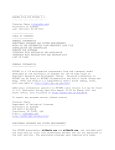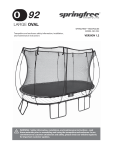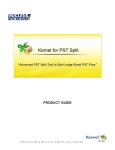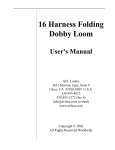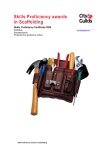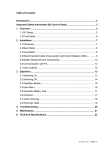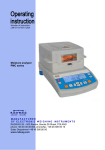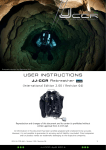Download Quick Dam Water Gate Manual
Transcript
TM Instructions & Operator Manual TABLE OF CONTENTS GENERAL INFORMATION ..............................................................................................................2 FOUR GOLDEN RULES TO FOLLOW ............................................................................................3 DETERMINING THE HEIGHT AND LENGTH OF REQUIRED WATER-GATE ..............................4 CONNECTING WATER-GATES TOGETHER .................................................................................5 MAKE A CORNER OR CURVING THE WATER-GATE ..................................................................6 SETTING UP WATER-GATE ......................................................................................................7-10 HOW THE ENDS OF THE WATER-GATES SHOULD BE PLACED .............................................11 PROTECTING AN ENTRANCE .....................................................................................................11 ADHERENCE OF THE WATER-GATE WHEN INSTALLED ON A SMOOTH SURFACE ............12 ELIMINATION OF WATER INFILTRATIONS UNDER THE BARRIER ..........................................14 IMPORTANCE OF NOT TYING THE WATER-GATE TO THE GROUND ....................................14 IMPORTANCE OF HAVING WATER PUMPS ...............................................................................14 FOLDING UP THE WATER-GATE FOR STORAGE .....................................................................15 MAINTENANCE ............................................................................................................................16 STORAGE, REPAIRS, DURABILITY & WARRANTY.....................................................................17 TECHNICAL FABRIC SPECIFICATIONS .....................................................................................18 BEHAVIORS AND STRETCHING OF THE PARTITIONS .............................................................19 PRESSURE EXERCISED ON ANY PART OF THE PARTITIONS ................................................19 DISCHARGE OF WATER DUE TO THE PRESSURE ..................................................................20 CALCULATION OF THE PRESSURE ......................................................................................20-21 CALCULATION OF INSTALLATION TIME ....................................................................................22 SIZE AND WEIGHTS OF UNITS ...................................................................................................23 FREQUENTLY ASKED QUESTIONS .......................................................................................24-27 1. RESPONSIBILITY Before using your Water-Gate, it is essential to read the entire user guide and conduct at least one preliminary test. This is meant to ensure you master all the steps required for installing the Water-Gate. The vendor and manufacturer shall in no way be responsible for faulty installation and/or faulty use of the Water-Gate. HOW THE WATER-GATE WORKS The principle is simple: water accumulates inside the barrier and exerts pressure on the bottom of the fabric, which keeps the barrier in place. The speed or direction of the incoming water is not important, as it is the water pressure that causes the barrier to open up. WATER HOLDING BACK WATER 4 3.8 3.8 to 4to times The surface of the barrier on the ground is 4 times greater than its water retention height, which means it has 4 times more vertical thrust ( toward the ground) than horizontal thrust, allowing for good adherence. In order for water to be able to hold back water on most surfaces such as asphalt or grass, a ratio of 1 to 2½ is generally sufficient to ensure safety. With a ratio of 1 to 4 the Water-Gate barrier is obviously very safe and the chances of it slipping are very slim. The wider the barrier is the less likely it is to slip. To conclude, the Water-Gate water barrier is 33% safer than required. MAIN FEATURES OF THE WATER-GATE E Designed for flood control. A - Polyester fabric coated with super heavy-duty, abrasionresistant PVC suitable for use on all types of surfaces. B - Stretched partitions providing better adherence to smooth surfaces. C - Polypropylene straps to lift up the ends during specific installations D - Galvanized metal plate ballast weights held in polyester netting sewn to the Water-Gate . E - Extra resistant polypropylene straps to facilitate handling. 2. D B C A FOUR GOLDEN RULES TO FOLLOW 1. Pump the water at the back of the barrier Its important to leave a reasonable amount of space between the building and the back of the Water-Gate. Leave room to install a water pump and be able to move freely. Rain, storm water & water seeping underneath the Water-Gate should not be left to accumulate behind the barrier. Having too much water behind the unit can cause unbalancing issues, so be sure to pump out the access water. 2. Place an even amount of weight at the front Do not tie the Water-Gate to the ground, as it uses the weight of the water to stop oncoming water. However, it is very important to place even weights along the entire length of the front flap to minimize water infiltrations underneath the Water-Gate and keep it on the ground. 3. Prevent water from accumulating under the Water-Gate Remove all objects likely to create water infiltrations under the barrier flap. The barrier is designed to stay in place on all surfaces such as asphalt, gravel, lawns and concrete paving blocks, but if there is too much water under the flap, the Water-Gate will not adhere as well and may slip. It is thus, important to make sure the ground is free of objects that could cause water to accumulate under the Water-Gate. 4. Never try to contain a leak at the back of the Water-Gate If there are leaks, stop the water from coming in at the front of the barrier. In most cases, such problems are caused by water infiltrations at the front. Trying to contain a leak at the back of the Water-Gate will create a pool of water and make the Water-Gate unstable. NEVER SET THE BACK OF THE WATER-GATE AGAINST A WALL If you set the back of the water barrier against a wall, water will slowly accumulate between the wall and the Water-Gate will then seep into your building. This will also have the effect of destabilizing the Water-Gate. Right method Wrong method INSTALLATION ON A MANHOLE Under no circumstances should you install your water barrier on a manhole, unless you are absolutely sure that it will not overflow during the flood. If your water barrier has to be set up in a location where there is a manhole, you must absolutely find a way around the manhole and choose another path. The simplest solution is to install the barrier behind the manhole. You can also set it up in front. If you choose this second solution, you will have to close up the manhole. We offer our Drain Plug for such situations. 3. DETERMINING THE HEIGHT AND LENGTH OF REQUIRED WATER-GATE Straight lines are easy to determine, but we recommend adding 1% to 3% of extra barrier length. This slight addition is necessary due to the imperfections of the surface. To go around a building, the calculations are somewhat more complex, but our instructions will help simplify your installation. 1. Keep an adequate amount of space between the protective Water-Gate and the building: No matter where you decide to set up the Water-Gate, you A need to have an adequate amount of space A to be able to move around and place pumps of appropriate capacity to never rest against the wall of a building. To maximize protection, set up the barrier as far as possible from the location you want to protect. 2. Determine the water level of the flood: Water level Water level reaching the house reaching the house It is important to choose barriers that are not smaller than required for the expected water level. Be careful on sloping ground, as the 2X water level reaching the house will certainly be lower than the 1X water level where your barrier will be installed. As soon as you have chosen the barrier with the right water retention capacity, calculate 2 times its water retention to determine where to place Sloping ground Sloping ground the back of the water barrier. Direction of water flow B 3. Determine the length of the barriers: To determine the required widths and lengths, it is critical to measure the distance to the outermost point B on the barrier and also consider the relief of the ground. You must also add 1% to 3% in Adequate space length to cover the imperfections on the ground. In the opposite illustration view from above, the red line B (or ballast weights) determines the length of the required barriers. View from above C A = Adequate space at the back of the barrier 1X = Size of water retention 4X = Size 4 times the water retention size from ballast weights to back of barrier B = Ballast weights already attached A 4X B 1X C = Calculation distance for barrier length from structure 4. Side view CONNECTING WATER-GATES TOGETHER BOTH WATER-GATES MUST BE COMPLETELY UNFOLDED AT THE ATTACHMENT JOINTS. All our Water-Gates, regardless of size (water retention), can be connected together, except for the smallest 6” / 15 cm model, which can only be connected to barriers of the same size. To connect two Water-Gates, a straight surface is required, especially under the joint where the two Water-Gates will be attached. Do not connect Water-Gates together in moving water. If the temperature is below freezing, the water in the velvet strips and hooks may freeze, making it impossible to connect Water-Gates together. 1. The first step consists in completely unrolling and unfolding the two Water-Gates and laying them next to the other. 2. Make sure the back side of the Water-Gates are even and the joints and hook & loop fastening strips are open and even with each other 3. Open the top fabric on each side to uncover the bottom joints and insert the Water-Gate on the right into the one on the left. 4. Close up the hook and loop fasteners by laying them one on top of the other from the back. 6. When you are done with the joint at the bottom, insert the partition of the Water-Gate on the left side into the right side of the partition of the Water-Gate on the right and close off the top parts. 7. Close up the hook and loop fasteners by laying them one on top of the other, the same as you did for the bottom joint. 5. Keep closing up the hook and loop fasteners starting in the back working to the front from the back until you end at the front. 5. Use the same method to tie together two Water-Gates of different sizes. Make sure the two Water-Gates are aligned at the back. Follow the same directions as in steps 1-5 above. Follow the same directions as in steps 6 above. Follow the same directions as in steps 7 above. The two Water-Gates are now attached. MAKE A CORNER OR CURVING THE WATER-GATE To make a corner or curve the barrier MUST BE COMPLETELY UNFOLDED. Back side of the barrier is the determining length when curving the Water-Gate.The furthest edge of the barrier must always be taken into consideration to determine the length of the required Water-Gates. The green dotted line on the photograph shows the required Water-Gate length. The Water-Gates can be curved to any given angle, however we recommend curving it in such a way as to divert the water. When the Water-Gate is curved you must take extra caution to ensure that water does not seep underneath by ensuring that the front has no folds that water can get underneath. Use sand bags or other weighted objects & place them on top of these folds. Too much water seeping underneath can cause the Water-Gate to slip. Method used to contain water Not recommended Here are 4 installation methods don’t worry about the deployment of the Water-Gate, as the pressure from the water will force the corner to be deployed properly. Method used to repel water (Recommended) 6. 1. Square corner to repel the water: This method is the one most often used to protect a building. The Water-Gate can be curved to all angles, including angles greater than 90º. WATER FLOW BACK OF WATER-GATE 1 - Completely unfold the Water-Gate. 2 - Place ballast weights on the front flap of the Water-Gate and turn to the desired angle. 3 - Pull the material closer and smooth out the top fabric. 4 - You can remove the ballast weights used to make the corner. The Water-Gate should now look like this. 7. 2. Square corner to contain the water: This method is rarely used and is not recommended, but can work very well if you are able to eliminate the infiltrations at the front and especially at the corner of the Water-Gate. BACK OF WATER-GATE WATER FLOW 8. 1 - Completely unfold the Water-Gate. 2 - Place ballast weights at the back of the Water-Gate and curve the barrier to the angle required to contain the water. 3 - Pull the material closer and smooth out the upper fabric. 4 - Place ballast weights over the entire surface of the front flap to prevent infiltrations at the joints. 3. Making a round curve to REPEL the water: Mainly used for winding roads, this type of deployment is generally made using several Water-Gates contained in a crate and pre-connected together. If the curve is pronounced, it is better to completely unfold the rounded section of the pre-connected to make sure the ballast weights are evenly distributed on the ground. BACK OF WATER-GATE WATER FLOW 1 - Completely unfold the Water-Gate. 2 - Give the Water-Gate the desired curve. Ballast Weights (optional) 3 - Keep the ballast weights at the back evenly distributed to keep the fabric on the ground and prevent the wind from lifting up the Water-Gate. 4 - Without ballast weights, the folds in the fabric are exposed to the wind. This opening may cause the Water-Gate to be lifted, jeopardizing the installation. 9. 3. Making a round curve to CONTAIN the water: Used on winding roads, but in the opposite direction as that shown in the previous figure. If the curve is somewhat pronounced, the rounded erection of the Water-Gate must be completely unfolded. Such particular attention is required to make sure that the Water-Gate is not stretched and to prevent water infiltrations from underneath the steel plates, which will tend to compress and lift up. BACK OF WATER-GATE WATER FLOW 1 - Completely unfold the Water-Gate. 3 - Place a second series of ballast weights along the entire length to prevent water infiltrations. 10. 2 - Curve the Water-Gate as needed, making sure the back of the Water-Gate is not stretched. 4 - Sandbags can also be used to close off the spaces or folds formed by the Water-Gate ballast weights. HOW THE ENDS OF THE WATER-GATES SHOULD BE PLACED. The ends of the Water-Gates are not closed off, so they must rise up higher than the level of the flood. Since the water flows freely inside the Water-Gates, the front and/or back sides of the Water-Gates must be higher than the maximum flood water level. The 3 photographs below different options for sealing off the ends. Extra Water-Gate length will also provide maximum safety. Tie off straps where necessary to hold up on vertical walls. E E Weight against structure to hold in place. D = Flood water level or maximum water barrier opening. E = Extra barrier length. We recommend a minimum extra length of up to 50% depending on the flood water level. In addition, every time the Water-Gate is abruptly lifted against a wall, a space is created and water will infiltrate from the corner. We strongly recommend placing one or more sandbags on that corner. The water pressure exerted on the Water-Gate stretches the fabric, thus creating a wider opening promoting infiltration in that corner. PROTECTING AN ENTRANCE The Water-Gate is not designed to be installed in a door frame. For adequate protection, you must go around the door and lift up the ends of the Water-Gate on each side of the wall. This type of protection requires extensive barrier length based on a calculation of the exterior Water-Gate contour. Using Water-Gate for your doors will give you better protection, as you will be able to pump up any water infiltrations before they reach your door. You will also maintain access to the exits of your buildings at all times. If you decide to only protect the entrances instead of all the walls of your building, make sure that no water can seep in through the walls. The opposite photograph shows an air hole in a brick wall. Such holes are found on all insulated brick walls. Make sure you fill in these small holes before the flood and clear them again after the flood. 11. ADHERENCE OF THE WATER-GATE WHEN INSTALLED ON A SMOOTH SURFACE Usually none of these precautions are necessary, but we believe that if you use one or two of these methods at the same time, it would be impossible for the Water-Gate not to stay in place. The water pressure exerted on the fabric at the bottom of the Water-Gate is 4 times that of the pressure exerted on the side ( see “WATER HOLDING BACK WATER”), which is more than sufficient to hold down the Water-Gate on most surfaces found outdoors (asphalt, lawn, gravel, concrete paving blocks,etc.). However, some exceptionally smooth surfaces, such as tarred asphalt or polished cement, require particular attention. What happens with this type of surface is that the water stays trapped between the fabric at the bottom of the barrier and the smooth surface causing loss of surface tension. The result is similar to HYDROPLANING when driving with completely worn down tires. It is very important to understand what it takes to ensure that the Water-Gate adheres properly to the ground: AT NO TIME SHOULD WATER ACCUMULATE UNDERNEATH THE WATER-GATE. When deployed on regular asphalt, the Water-Gate is very safe due to the presence of small cracks in the asphalt which enables the water to drain through to the back of the Water-Gate. If the Water-Gate has to be installed on an EXTREMELY SMOOTH surface, simply take some additional precautions as shown below: 1. Apply a food substance such as molasses, caramel or even bread dough underneath the ballast weights and along the entire length. This substance will fill in the spaces between the bumps on your surface (asphalt, paving blocks, etc.) and will also stick very well to the fabric of the barrier. This process is ideal to eliminate water infiltrations and also improves adherence. This efficient technique is also environmentally safe! If theWater-Gate is installed on a lawn, you can make a trench and bury the front part (or ballast weights) of the barrier. 2. Place stakes at the back of the Water-Gate at a reasonable distance (1 to 3 meters / 3 to 10 feet) or even have the sides of automobiles rest against the back of the Water-Gate. This technique ensures that the Water-Gate will not slip. Should the Water-Gate begin to slip, it would gently be stopped by the stakes, posts or automobiles and would hold back the flood without damaging anything. 12. The Water-Gate can be installed fairly easily, even in high wind. The wind’s strength isn’t on the ground. Everything higher up that gets taken away by the wind ends up on the ground and eventually comes to a standstill. Since the water barrier gets unrolled on the ground, it is less exposed to the wind than objects further up! The Water-Gate can easily be kept on the ground in very strong wind, however, some additional precautions do have to be taken. Although the wind is less strong on the ground, a vacuum can be created on top of the barrier and cause it to lift up. If possible, to minimize the effect of gusting wind, keep the Water-Gate folded and add a sufficient number of ballast weights to keep it tight against the ground. When the flood water arrives, the barrier can be unfolded and will automatically deploy based on the position of the ballast weights. To ensure the Water-Gate is properly deployed, push off any ballast weights that are in the way. Increase the number of sandbags if the wind gets too high. Their weight as well as the pressure of the wind blowing on the surface of the fabric and against these sandbags will reduce the vacuum effect. Another solution is to place a net on the deployed Water-Gate. This net would be attached to the ground at the front and back of the Water-Gate. When the flood water arrives, it will go through the net and gather in sufficient quantity inside the Water-Gates to ensure a protection of several centimeters. After this is done, you can remove the net to allow the Water-Gate to be fully deployed. The water already in the Water-Gate will weigh enough to maintain the Water-Gate on the ground. 13. ELIMINATION OF WATER INFILTRATIONS UNDER THE BARRIER The secret of an effective Water-Gate installation starts be reducing water infiltrations under the Water-Gate to a minimum. To do this, it is important to remove any object underneath the Water-Gate in order to evenly place ballast weights on top. The Water-Gate could suddenly lift up due to waves or something, which would cause significant infiltrations at the corners. Therefore, we recommend putting sandbags on the corners to prevent them from lifting up. Be careful: When the flood water enters the Water-Gate, the fabric could retract and create new spaces allowing the water to flow under the barrier. You must always keep an eye out to make sure this doesn’t happen. IMPORTANCE OF NOT TYING TO THE GROUND 1. The Water-Gate tends to contract as it fills up with water. Tying down the Water-Gate will put tension on the front flap, which will create spaces for the water to flow through since the fabric cannot remain tightly against the ground. 2. Tying the Water-Gate to the ground can complicate things if a new configuration is required. IMPORTANCE OF HAVING WATER PUMPS No matter what type of protective dam you use, a certain amount of water will almost always flow into the protected area. Water pumps are as important as your protective barrier. Make sure that if a flood occurs you will be able to use your pumps and they will be in good operating condition. We strongly recommend having a generator to power all your water pumps or having gas operated pumps. Without these water pumps, the accumulated water leaks will invade your protected area and your protective dam will be useless. These leaks can be due to a number of different factors: • • • • Wet ground that becomes permeable Small cracks under or through the dam Sewage pipes Unbalanced water pressure due to the flood When you install one or more water pumps, it is important to leave enough space between the building and the back of the barrier to allow you to move freely and regularly check the pumps. Make sure your pumps have enough power to pump up all the water flowing under the Water-Gate and prevent this water from reaching the wall of the building. 14. It is hard to determine the number of pumps needed and their required capacity, but we do recommend having a minimum of 2 pumps, one for the basement and the other to put between the wall of the building and the protective dam. For water getting through your dam, you will need a pump with a capacity of 1/2 gal to 3.75 gal per min for each linear yard of dam. The required pump capacity mainly depends on the type of ground involved and where the dam is installed FOLDING UP THE WATER-GATE FOR STORAGE It is very important to fold each Water-Gate as it should be. Folding the Water-Gate (model WL-1430 illustrated) 2 - Using a stick, make sure all partitions are smoothed out to enable you to fold up the Water-Gate tightly so that it can be easily inserted in its bag once rolled up. 1 - After cleaning and drying the Water-Gate, stretch it out on a large flat surface. 3 - Before folding the Water-Gate, keep all the joints open to make it easier to tie a second Water-Gate to it, if need be. 4 - Start folding from the back so that the ballast weights will be positioned in the middle and under the Water-Gate. Use the folds already appearing on the fabric as a reference. Please note that the folding pattern and number of folds differ for each size of barrier WL-06 and WL-14 Model WL-20 and WL-26 Model WL-39 Model 1 fold only 2 folds 3 folds 15. 5 - Roll up on the side opposite to that of the instruction banner. 6 - After being properly rolled up, the Water-Gate should look like this. MAINTENANCE It is strongly recommended to wash and dry the Water-Gate after use, before storing it. This allows you to check for any damages that may have occurred during use. Cleaning the product with a pressure washer is strongly recommended. Dirt and trapped-in humidity do not affect the quality or the resistance of the Water-Gate, but could lead to unpleasant odors when the Water-Gate is used again. To clean the Water-Gate, hang it by the rear since it is equipped with at least one rear strap every 1.52m/5 feet. A fence or side of a garage are excellent places to wash and dry your Water-Gate. You have to install hooks on the top of your fence or on the edge of the garage. One hook will be required for each rear strap. If you plan on making continuous intensive use of the Water-Gate, you will need to have the right equipment for proper maintenance. Adjustable poles are available for Water-Gate with a water retention level of less than 28 inches / 71 cm.These poles make it easier to hang up the Water-Gate. All you need to do is fasten the back of the Water-Gate at shoulder height, and then extend the poles above your hands. One pole will be required for each strap. To measure the exact distance required to install the hooks or adjustable poles, we suggest unrolling the Water-Gate next to the place you’ve chosen for washing and placing a hook facing each rear strap. 16. STORAGE The Water-Gate can be piled one on top of the other, upright or flat, without this hampering their deployment. However, storing the Water-Gate in a vertical position is highly recommended to maintain its shape when rolled up. We don’t recommend setting the Water-Gate directly on a damp surface. It is best to lay on a wooden pallet. If there is water trapped inside the Water-Gate during storage, this will not affect product longevity as long as the water is dirt free. Fallen leaves and other waste material left inside the Water-Gate can damage and dry up the fabric, thus reducing the useful life of the Water-Gate. When the Water-Gate is properly washed and stored, it does not emit any odors. However, improper cleaning and storage may lead to some unpleasant odors when the Water-Gate is deployed once again. Every Water-Gate should be kept in its storage bag or crate for protection against UV rays, dirt, and damages, as well as easier handling during transport. Rodents are not attracted to polymer canvas and will not chew this type of material. REPAIRS In the event that your Water-Gate is damaged in any way, we suggest you get it repaired by professionals who are used to working with this kind of material. Take your Water-Gate to a business that usually works with canopies, canvas truck covers, tents or car shelters. This could even be your local shoe repair store. Repairs can vary in cost depending on the damages incurred. 1. If there is a tear or perforation in the PVC canvas, several methods can be used. These include contact cement for PVC, ultrasonic or thermal gluing, or sewing to another piece of material. 2. It one or more partitions are torn along the seems, it could be very difficult and maybe even impossible to repair such damages. However, you can cut your Water-Gate in half, pull out the ripped or damaged partitions, and glue your Water-Gate back together. DURABILITY Water-Gates are entirely made of polymer, with estimated longevity of the product of over 20 years if the product is used occasionally and/or for short periods. Ultraviolet rays remain the most harmful factor for the components of the Water-Gate. However, the polymer canvas has been treated to counter the harmful effects of ultraviolet rays. Materials resit temperature of +50°C/+120°F to -40°C/-40°F. Even when stored for several years at these temperatures (maximum 10 years), the Water-Gate remains as effective. WARRANTY Each Water-Gate is manufactured and inspected according to strict quality standards. A registration number is printed on the ends of each Water-Gate, which is warranted against all manufacturing defects. 17. TECHNICAL FABRIC SPECIFICATIONS Fil l p ar W The technical specifications in the chart below are minimum requirements for all specified properties. These specifications enable us to guarantee out durability standards, which are three times higher than required. You have our assurance that in the majority of cases, our fabrics are much more resistant than the specifications outlined below. PVC Fabric For models WL-06, WL-14, WL-20 & WL-26 For models WL-50 and WL-60 Properties Weight Base Fabric Minimum Specifications Minimum Specifications 610 g/m² - 18 oz yd² Woven polyester scrim Warp 40 kg/cm 245 lbs/in Tension resistance * Tear resistance Adhesion Heat resistance UV resistance Warp Fill*** 32 kg 22 kg 72 lbs 49 lbs Warp Fill*** 1.5 kg/cm 1.5 kg/cm 8 lbs/in 8 lbs/in / -30º +70ºC -22º +160ºC More than 80% strength retention after 2000 hours of exposure Flame resistance Not applicable Polyethylene woven fabric Properties Weight Base Fabric Tension resistance * For models WL-06, 14, 20, 26 200 g/m² - 6 oz yd² 100% polyethylene Warp Fill*** 34 kg/cm 30 kg/cm 210 lbs/in 185 lbs/in Warp 31 kg 68 lbs Resistance to cold temperature Yes Warp 55 kg/cm 310 lbs/in Yes Yes Yes No Fill*** 31 kg 68 lbs Fill*** 50 kg/cm 275 lbs/in Warp Fill*** 45 kg 35 kg 100 lbs 80 lbs Warp Fill*** 1.5 kg/cm 1.5 kg/cm 8 lbs/in 8 lbs/in / -30º +70ºC -22º +160ºC More than 80% strength retention after 2000 hours of exposure **Certified Yes Yes Yes Yes Yes No No Not applicable No **Certified For models WL-39, 50, 60 **Certified Minimum Specifications Yes Yes Yes 300 g/m² - 9 oz 100% polyethylene Warp Fill*** 80 kg/cm 50 kg/cm 490 lbs/in 320 lbs/in Warp 40 kg 88 lbs Fill*** 40 kg 88 lbs Yes Yes Yes -40ºC / -40ºF Yes -40ºC / -40ºF Yes More than 80% strength retention after 2000 hours of exposure Yes More than 80% strength retention after 2000 hours of exposure Yes Not applicable No Not applicable No Flame resistance 18. Yes - 750 g/m² - 22 oz yd² Woven polyester scrim Minimum Specifications Tear resistance UV resistance Fill*** 35 kg/cm 218 lbs/in **Certified Lbs/in. = Pounds/inch = lbf * Tension resistance or grab tensile yd² = square yard ** Certified = tested according to recognized standards g/m² = GSM *** Fill or Weft BEHAVIORS AND STRETCHING OF THE PARTITIONS In this illustration, it can be seen how we each partition behaves to the increasing water pressure inside the Water-Gate. These partitions prevent the upper canvas from tipping backwards. Via the components principle of equilibrium of forces. The partitions of the Water-Gate are made of non-expandable polyethylene; A rigid material recognized for its strength. Thus, due to this concept, it is impossible that the distribution of tensions between each partition. PRESSURE EXERCISED ON ANY PART OF THE PARTITIONS In this illustration, we can observe the pressure exerted on each part of the partition. The figure uses abstract units of tension to demonstrate the distribution of the applied forces. The red indicated the robustness to tension applied on each partition. 0 1.0 3.0 4.0 5.0 5.5 1 6.0 2 3 6.0 4 5 6.0 6 7 6.0 8 9 6.0 10 6.5 We can observe an area which has a point of force superior to any other. It is here on the partitions that receive the most tension. It is also at a point which our calculations of strength and sturdiness have been made. The tensions inscribed on the canvas are figures based on our expertise and our observations. 19. DISCHARGE OF WATER DUE TO THE PRESSURE When the Water-Gate is filled with water, the pressure it distorts the straight portions of that upper canvas and the background to make rounded aspects between each partition. The pressure exerted on the upper canvas raises the partitions leaving a discharge space so that the incoming water is not trapped below the surface of the Water-Gate. Thus, this space acts as a discharge path much like those of a tire tread pattern or the sole of a boot. Due to this principle, the Water-Gate boasts superior adhesion to the ground far surpassing any other flood products. The gray part on the drawing represents the partition. An important technical reference was made to back the fence. The rounded design limits the swelling of the rear portion of the Water-Gate and forms a single unbroken line with the upper part of the canvas. Thus preventing any weakening which could create a tear from the wall. (the rounded part “Arc” is small enough not to create tension on the point “from the seam of the partition”). CALCULATION OF THE PRESSURE Since we know the highest points of tension exerted on each partition, we can calculate the force exerted in order to ensure that the partitions resist more than 3 times the pressure of the water (a norm established for Water-Gate products) to insure a very safe and reliable product. 26½" 67 cm Water pressure exerted 15 cm 6" 20. 30.5 cm 12" Point of maximum tension IMPERIAL SYSTEM Example for model WL-26 (26½ inches of water retention) Therefore: 26½” - 6” = 20½ inches of pressure (or column of water) For each inch³ of pressure, we must calculate 0.0362 pound. Therefore: 0.0362 x 20½ = 0.742 lb The distance between each partition is 12 inches Therefore: 12” x 0.742 = 8.904 pounds (The maximum point of tension on the barrier). The security margin must be at least 3 time higher. Therefore: 8.904 x 3 = 26.71 pounds of tension. The test results indicate that the barrier’s stitching can withstand a maximum of 40 lb / inch which guarantees a more than sufficient security value. METRIC SYSTEM Example for model WL-26 (67 cm of water retention) Therefore: 67 cm - 15 cm = 52 cm pressure (or column of water) For each cm³ of pressure, we must calculate 1 g. Therefore: 1 x 52 = 52 g The distance between each partition is 30.48 cm, Therefore: 30.5 cm x 52 = 1,586 kg (The maximum point of tension on the barrier). The security margin must be at least 3 time higher. Therefore: 1.586 kg x 3 = 4,758 kg of tension. The test results indicate that the barrier’s stitching can withstand a maximum of 7.14 kg / cm which guarantees a more than sufficient security value. 21. CALCULATION OF INSTALLATION TIME A Water-Gate stored in a crate can be deployed in a straight line at the speed of someone running a marathon, that is approximately 19 km/h (or one 15-m/50 foot barrier every 3 seconds), regardless of Water-Gate width. However, if you have to bend or tie a Water-Gate or make a corner at an angle, you will have to completely unroll the Water-Gate and add the estimated time based on the Water-Gate width and type of application. The diagram below provides a good estimate of how much time you will need, based on your application. Deployment in a straight line can be done at the speed of a marathon runner. Individual rolled Water-Gate: To enable them to be carried to the location of the flood, these Water-Gates are wrapped in storage bags equipped with solid straps to facilitate handling by one or more people. The table below shows the estimated time it takes to install a Water-Gate with a length of 15m/50 feet. In a straight line 1 km to 15 km per hour Barrier’s size Estimated time Barrier’s size Estimated time WL-06 WL-14, 20, 26 WL-39, 50 WL-60,78 30 sec./ 1 pers. 1.5 min./ 1 pers. 2 min./ 2 pers. 3 min./ 3 pers. WL-06 WL-14, 20, 26 WL-39, 50 WL-60,78 1 min./ 1 pers. 3 min./ 2 pers. 3 min./ 3 pers. 4 min./ 3 pers. Unroll the barrier in a straight line Barrier’s size Estimated time Barrier’s size Estimated time WL-06 WL-14, 20, 26 WL-39, 50 WL-60,78 15 sec./ 1 pers. 1 min./ 2 pers. 2 min./ 3 pers. 3 min./ 3 pers. WL-06 WL-14, 20, 26 WL-39, 50 WL-60,78 1 to 2 min./ 1 pers. 1 to 4 min./ 2 pers. 2 to 5 min./ 3 pers. 3 to 7 min./ 3 pers. Making a corner for angles of 5º to 125º 22. Tying together two barriers Curving the barrier for angle greater than 5º SIZE AND WEIGHT OF INDIVIDUAL WATER-GATES (With storage bag) WL-0630 WL-1430 WL-1450 WL-2030 WL-2050 WL-2630 WL-2650 WL-3930 WL-3950 WL-5050 WL-6050 40 x 38 x 26 H 16” x 15” x 10½” H 38 x 106 x 25 H 15” x 42” x 10” H 48 x 106 x 30 H 19” x 42” x 12” H 17” x 29” x 12” H 43 x 74 x 30 H 22” x 29” x 14” H 56 x 74 x 35 H 40 x 104 x 28 H 16” x 41” x 11” H 56 x 104 x 36 H 22” x 41” x 14” H 46 x 117 x 33 H 18” x 46” x 13” H 61 x 117 x 40 H 24” x 46” x 16” H 66 x 127 x 46 H 26” x 50” x 18” H 76 x 127 x 51 H 30” x 70” x 20” H 24.5 25.7 42.1 32.7 53.6 41.4 68.2 89 145 173 204 54 56.6 92.6 72 118 91 150 195 320 380 449 WL-0630 SIZE AND WEIGHT OF CRATED WATER-GATES To purchase crated Water-Gates, there is a cost over and beyond that quoted These extra amounts are charged for two reasons: 1 - Folding the Water-Gates to be packed in crates required more time for our employees than packing individual Water-Gates. 2 - The cost of the crate can vary substantially based on your needs. A crate can be made out of pallet wood, pressure-treated wood panels, painted to your specifications or even be built from steel and assembled on wheels. It all depends on your requirements. As an example, the cost can represent 1 to 4% of the purchase price of the barrier when the crate is made out of wood. A - Size can vary by 2 to 8% B - Maximum size per crate C - Size based on requirements Because A varies little and B is a maximum size, cases can be piled up or placed one beside or behind the other, to fit the available space in your emergency response unit. 23. A few examples of the size of the areas required for crated Water-Gates Barrier model Outer dimension of crate (water retention) A B C WL-0630 15 cm / 6 in 50 cm 20 in 60 cm 24 in WL-1450 35 cm / 14 in 1.12 m 44 in 1.12 m 44 in 1 m / 3’-3” 5 m / 16’-5” 2.5 m / 8’-3” 5 m / 16’-5” WL-2050 1m 1.12 m 50 cm / 20 in 40 in 44 in WL-2650 67 cm / 26½ in 1.20 m 47 in 1.12 m 44 in WL-3950 1 m / 39 in 1.36 m 54 in 1.12 m 44 in WL-5050 1.3 m / 50 in 1.70 m 67 in WL-6050 1.5 m / 60 in 2m 79 in 1.12 m / 44 in 1.70 m / 67 in 1.12 m / 44 in Number of Water-Gates Total length of protection Total weight (barrier only) 6 55 m / 180 ft 292 m / 960 ft 274 m / 900 ft 609 m / 2,000 ft 150 kg / 330 lbs 790 kg / 1,750 lbs 760 kg / 1,670 lbs 1.68 Tm / 1.85 tons 1,829 m / 6,000 ft 198 m / 650 ft 442 m / 1,450 ft 5.1 Tm / 5.56 tons 700 kg / 1,550 lbs 1.56 Tm / 1.71 tons 1,356 m / 4,450 ft 198 m / 650 ft 427 m / 1,400 ft 1,310 m / 4,300 ft 183 m / 600 ft 4.8 Tm / 5.25 tons 890 kg / 1,950 lbs 1.91 Tm / 2.1 tons 5.9 Tm / 6.5 tons 1.75 Tm / 1.9 tons 410 m / 1,350 ft 1,265 m / 4,150 ft 3.93 Tm / 4.3 tons 13.3 Tm / 13.3 tons 86 290 m / 950 ft 1,310 m / 4,300 ft 3.24 Tm / 3.6 tons 14.7 Tm / 16.1 tons 14 82 213 m / 700 ft 1,250 m / 4,100 ft 2.8 Tm / 3.1 tons 16.2 Tm / 17.8 tons 13.6 m / 44’-7” 2.5 m / 8’-3” 5 m / 16’-5” 13.6 m / 44’-7” 2.5 m / 8’-3” 5 m / 16’-5” 13.6 m / 44’-7” 2.5 m / 8’-3” 5 m / 16’-5” 13.6 m / 44’-7” 2 m / 79 in 5 m / 16’-5” 13.6 m / 44’-7” 5 m / 16’-5” 13.6 m / 44’-7” 32 18 40 120 13 29 89 13 28 86 12 27 83 19 FREQUENTLY ASKED QUESTIONS: What happens if fragments in and on the water smash against the Water-Gate? The Water-Gate has the amazing ability to hold back all fragments in the water due to its great flexibility. If one or more large objects are being projected at high speed against the barrier, be it from a parallel, sideways or perpendicular angle, the barrier will act like a spring. The object being thrust against the barrier will automatically be pushed away from the barrier with little risk of damaging it. If there are fragments floating on the water they will fold down the top of the barrier as they hit it, go over it and end up at the back of it. Should the barrier get hit very hard by a floating object, it could tear at the top. However, we are confident that it would hold out until the flood was contained. A 24. B C D If a wall or a tree falls on the barrier during a flood, what solution do you propose? The Water-Gate will simply wrap itself around the object that fell on it and only a small amount of water will go over the Water-Gate. All you have to do is remove the fallen object, and the Water-Gate will regain its original position. The risk of tears from an object falling on the Water-Gate is pretty low. Should there be a hole or a tear, it can easily be repaired be placing a piece of fabric inside the Water-Gate. The fabric will adhere to the inside wall simply from the pressure of the water entering the Water-Gate. What skills are required for installation? Is training necessary? No particular skills are required. However, basic training is recommended. Installation is simple but does require a minimum of understanding. Chances are you will find everything you need to know in this manual. If you have any questions after going through it, a technician will be happy to give you more information. Can the Water-Gate system open up fast enough to stop waves? The Water-Gate will open at the same speed as that of any waves coming in. This means that regardless of the speed of the oncoming water, the Water-Gate will open up like a parachute does in the wind. However, if a wave has white caps on top of it, the surplus of water will go over the Water-Gate and will need to be pumped. To contain all types of waves, Water-Gate can remain open; There are small holes at the base and at the top of the partitions in which stiff rods can be inserted to keep the barrier open at all times. If the flood is a mudflow, and huge rocks get dragged down, will the Water-Gate withstand the flood? Yes, the water barrier can easily withstand the pressure from a mudflow. As mentioned in the Manual, the Water-Gate is at least three times stronger than required. Given the fact that the density of thick mud is approximately 1.65, the safety margin is excellent. As far as the presence of large rocks is concerned, at the beginning, there is more water than mud and there are no rocks. Medium size rocks are typically found upstream and larger rocks are even further upstream. Based on our expertise, we know that the barrier will first fill up with relatively thin mud. Medium size rocks will arrive next. The larger rocks will only be found at the end and will never reach the Water-Gate. Because of this, a mudflow will not compromise the safety of the Water-Gate. 25. Mud with rocks of average size Mud with large rocks Mud with large rocks Mud with any rock of imporance Mud with rocks of average size Mud with rocks of average size Mud with any rock of imporance Mud with any rock of imporance Illustration Mud with no large rocks A Mud with medium rocks B Mud with large rocks Mud with medium rocks Mud with no large rocks C Mud with large rocks Mud with medium rocks Mud with no large rocks If the Water-Gate is left for several months or even several years in a stream, will it stay in place during that period? Yes, the Water-Gate will stay in place provided the water level is not much higher than the top of the Water-Gate. Do not forget that the flow of a stream never remains the same due to alternate periods of drought and abundant rainfall. Also, in northern areas, the water barrier can be distributed by moving ice. Observation: If the Water-Gate remains in a stream for a month or longer, a light coat of silt will form inside, on the fabric at the bottom of the immersed Water-Gate. After four months, only 50% of the fabric will remain visible due to the thickness of the silt. Will the Water-Gate withstand parallel water flow? Parallel water flow is not a problem. In the example below, there was more water flowing than the Water-Gate intended to withstand, and the current was swift. In the same trail with lots of parallel flowing water, we attempted to damage the Water-Gate with wood fragments. Our testing process was rigorous but did not result in any damage to the Water-Gate. 26. What about leaks from the Water-Gate system? No flood control system is 100% leak proof. Even if a system were completely watertight, there would be leaks through the ground from waste pipes, in addition to rainwater falling on the part of the ground that you are trying to protect. Water leaking through the Water-Gate generally flows under the Water-Gate. Leaks occur because of the unevenness of different surfaces. However, the more the Water-Gate barrier fills up with water, the more water tight it becomes. If the water barrier is laid down on a regular asphalt surface, with 4 in (10 cm) of retained water, the size of the leaks can be around 1 Gal/min/linear 3 ft. However, if the barrier retains 20 in (50 cm) of water, only about 1/2 Gal/min/ 3 ft will leak from it. Your emergency plan should definitely include pumps to remove any water leaking through the Water-Gate. We recommend using gas powered water pumps that do not depend on electrical power and plan to plan for leaks that may be greater than the amount of water expected to flow under the barrier. Will the Water-Gate barrier withstand freeze-thaw cycles? Our PVC fabric manufacturer warrants it products against cracking at a temperature of -22º F (celsius), and the polyethylene partitions are guaranteed to withstand temperatures as low as -40º F/C. The PVC fabric and polyethylene used to make our barriers are the same as those used for road transport and car shelters. They are very resistant to extreme temperatures and have proven their worth over several decades of freeze-thaw cycles. The water barrier in the photograph below was placed in a stream at a temperature of -4º F (C)for a period of three days. A layer of ice formed on the inside, at the top of the PVC (yellow) fabric, but was very easy to remove by just tapping the barrier. The ice came unstuck, immediately floated to the top of the barrier, slid over it and ended up behind it. We were then able to dismantle the barrier in the same way as in summer, with the exception that the remaining water quickly formed into ice crystals, and the barrier became instantly dry and clean. 27.




























